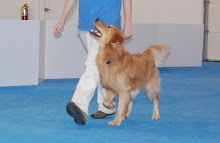My camera frequently comes out when I'm working with my dogs and during advanced/competition classes. After training or going to a trial with an out-of-town friend and student we will spend weeks looking over the videos we take. But why?
Everything is on the screen! The timing, cues (intentional and unintentional), dog responses, handler responses, successes, and areas for improvement are all right there. The video can be played, re-played, watched slowly, and compared to another clip. After reviewing a clip, I can make notes on what we need to work on next time and areas of improvement. And the best part is that progress over time can be monitored.
Here's a video clip that we (The Ohio 4-H Teen Dog Experience) showed during an animal presentation at the Ohio 4-H Teen Conference in February.
Now, it's our goal to focus on the things that go right:
-Griffin completes each part
-Griffin is precise
-Griffin is straight on his Recall, Front, and when he sits at Heel
-Griffin is in the right locations
-I give clear cues
-I am sure he completes each part before cueing the next part
-Timing of cues
If we are working towards getting every little piece right, we also want to note where to make improvements and go from there. As I'm teaching, I make a quick mental note of the pieces we need to improve upon and then give clear instructions on what I am looking for (TAG points, though I do know I need to use that phrasing more often!). If this video clip was of students, I would think about these areas for improvement:
-Giving the verbal/visual Stay cues before stepping off
-Being sure the dog can respond to a visual or verbal cue
-Improving each behavior before asking for them together. The weak piece here was the recall
-Speed of the recall
-Latency of the recall
-Knowing how to respond to less-than-ideal responses *cough, that recall, cough*
After watching the clip with the student, or watching this happen in real-time, I will point out some of those fabulous great things that happened. It's important to note those, otherwise the student might not be aware of the great cueing, great timing, or correct performance from her dog. The next part of the lesson would be working through these 'areas for improvement.'
We will do some training to check that the dog could respond to just a verbal stay cue or just a visual stay cue. I will tell the student "Give the cue before you move your body at all," and we will go through a little training without the dog to be sure the student can cue before stepping forward. The next part of the lesson is spent on working through the recall to improve latency and speed (separately of course!). I will mention that we want to be sure each part is perfect before we put them together again, but if there is a poor performance we should stop the behavior in chain. In this situation, after the late recall response I probably should have turned and walked away with Griffin for more recall training.
Homework notes would have points about:
-Cueing in front of a camera and/or a mirror to be sure that the cue happens before motion.
-Exercises for improving speed of the recall
-Exercises for mproving latency, especially with the recall
I was tempted to break this post into two pieces but I can't find an appropriate place for that....this won't happen again! Pull out your digital camera and use it.
K
Monday, March 16, 2009
Subscribe to:
Post Comments (Atom)




No comments:
Post a Comment